Juan Liu
Spatially-Augmented Sequence-to-Sequence Neural Diarization for Meetings
Oct 10, 2025Abstract:This paper proposes a Spatially-Augmented Sequence-to-Sequence Neural Diarization (SA-S2SND) framework, which integrates direction-of-arrival (DOA) cues estimated by SRP-DNN into the S2SND backbone. A two-stage training strategy is adopted: the model is first trained with single-channel audio and DOA features, and then further optimized with multi-channel inputs under DOA guidance. In addition, a simulated DOA generation scheme is introduced to alleviate dependence on matched multi-channel corpora. On the AliMeeting dataset, SA-S2SND consistently outperform the S2SND baseline, achieving a 7.4% relative DER reduction in the offline mode and over 19% improvement when combined with channel attention. These results demonstrate that spatial cues are highly complementary to cross-channel modeling, yielding good performance in both online and offline settings.
ECHO: Frequency-aware Hierarchical Encoding for Variable-length Signal
Aug 20, 2025Abstract:Pre-trained foundation models have demonstrated remarkable success in vision and language, yet their potential for general machine signal modeling-covering acoustic, vibration, and other industrial sensor data-remains under-explored. Existing approach using sub-band-based encoders has achieved competitive results but are limited by fixed input lengths, and the absence of explicit frequency positional encoding. In this work, we propose a novel foundation model that integrates an advanced band-split architecture with relative frequency positional embeddings, enabling precise spectral localization across arbitrary sampling configurations. The model supports inputs of arbitrary length without padding or segmentation, producing a concise embedding that retains both temporal and spectral fidelity. We evaluate our method on SIREN (https://github.com/yucongzh/SIREN), a newly introduced large-scale benchmark for machine signal encoding that unifies multiple datasets, including all DCASE task 2 challenges (2020-2025) and widely-used industrial signal corpora. Experimental results demonstrate consistent state-of-the-art performance in anomaly detection and fault identification, confirming the effectiveness and generalization capability of the proposed model. We open-sourced ECHO on https://github.com/yucongzh/ECHO.
SE-VLN: A Self-Evolving Vision-Language Navigation Framework Based on Multimodal Large Language Models
Jul 17, 2025Abstract:Recent advances in vision-language navigation (VLN) were mainly attributed to emerging large language models (LLMs). These methods exhibited excellent generalization capabilities in instruction understanding and task reasoning. However, they were constrained by the fixed knowledge bases and reasoning abilities of LLMs, preventing fully incorporating experiential knowledge and thus resulting in a lack of efficient evolutionary capacity. To address this, we drew inspiration from the evolution capabilities of natural agents, and proposed a self-evolving VLN framework (SE-VLN) to endow VLN agents with the ability to continuously evolve during testing. To the best of our knowledge, it was the first time that an multimodal LLM-powered self-evolving VLN framework was proposed. Specifically, SE-VLN comprised three core modules, i.e., a hierarchical memory module to transfer successful and failure cases into reusable knowledge, a retrieval-augmented thought-based reasoning module to retrieve experience and enable multi-step decision-making, and a reflection module to realize continual evolution. Comprehensive tests illustrated that the SE-VLN achieved navigation success rates of 57% and 35.2% in unseen environments, representing absolute performance improvements of 23.9% and 15.0% over current state-of-the-art methods on R2R and REVERSE datasets, respectively. Moreover, the SE-VLN showed performance improvement with increasing experience repository, elucidating its great potential as a self-evolving agent framework for VLN.
Self-Supervised and Generalizable Tokenization for CLIP-Based 3D Understanding
May 24, 2025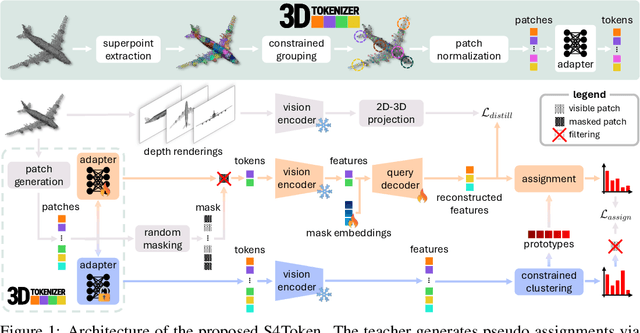

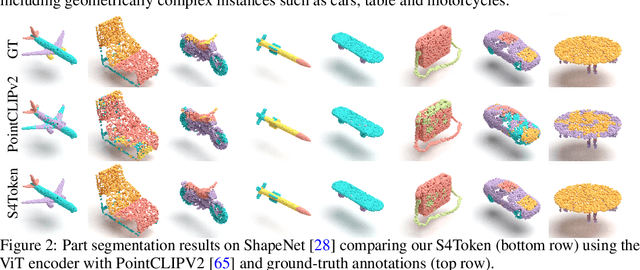
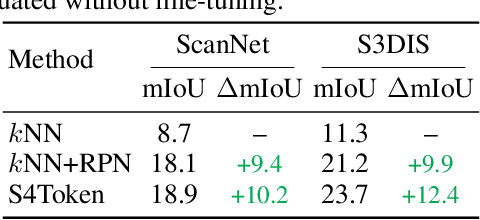
Abstract:Vision-language models like CLIP can offer a promising foundation for 3D scene understanding when extended with 3D tokenizers. However, standard approaches, such as k-nearest neighbor or radius-based tokenization, struggle with cross-domain generalization due to sensitivity to dataset-specific spatial scales. We present a universal 3D tokenizer designed for scale-invariant representation learning with a frozen CLIP backbone. We show that combining superpoint-based grouping with coordinate scale normalization consistently outperforms conventional methods through extensive experimental analysis. Specifically, we introduce S4Token, a tokenization pipeline that produces semantically-informed tokens regardless of scene scale. Our tokenizer is trained without annotations using masked point modeling and clustering-based objectives, along with cross-modal distillation to align 3D tokens with 2D multi-view image features. For dense prediction tasks, we propose a superpoint-level feature propagation module to recover point-level detail from sparse tokens.
Multi-Channel Sequence-to-Sequence Neural Diarization: Experimental Results for The MISP 2025 Challenge
May 22, 2025Abstract:This paper describes the speaker diarization system developed for the Multimodal Information-Based Speech Processing (MISP) 2025 Challenge. First, we utilize the Sequence-to-Sequence Neural Diarization (S2SND) framework to generate initial predictions using single-channel audio. Then, we extend the original S2SND framework to create a new version, Multi-Channel Sequence-to-Sequence Neural Diarization (MC-S2SND), which refines the initial results using multi-channel audio. The final system achieves a diarization error rate (DER) of 8.09% on the evaluation set of the competition database, ranking first place in the speaker diarization task of the MISP 2025 Challenge.
LOHA: Direct Graph Spectral Contrastive Learning Between Low-pass and High-pass Views
Jan 06, 2025



Abstract:Spectral Graph Neural Networks effectively handle graphs with different homophily levels, with low-pass filter mining feature smoothness and high-pass filter capturing differences. When these distinct filters could naturally form two opposite views for self-supervised learning, the commonalities between the counterparts for the same node remain unexplored, leading to suboptimal performance. In this paper, a simple yet effective self-supervised contrastive framework, LOHA, is proposed to address this gap. LOHA optimally leverages low-pass and high-pass views by embracing "harmony in diversity". Rather than solely maximizing the difference between these distinct views, which may lead to feature separation, LOHA harmonizes the diversity by treating the propagation of graph signals from both views as a composite feature. Specifically, a novel high-dimensional feature named spectral signal trend is proposed to serve as the basis for the composite feature, which remains relatively unaffected by changing filters and focuses solely on original feature differences. LOHA achieves an average performance improvement of 2.8% over runner-up models on 9 real-world datasets with varying homophily levels. Notably, LOHA even surpasses fully-supervised models on several datasets, which underscores the potential of LOHA in advancing the efficacy of spectral GNNs for diverse graph structures.
A Dual-Path Framework with Frequency-and-Time Excited Network for Anomalous Sound Detection
Sep 05, 2024Abstract:In contrast to human speech, machine-generated sounds of the same type often exhibit consistent frequency characteristics and discernible temporal periodicity. However, leveraging these dual attributes in anomaly detection remains relatively under-explored. In this paper, we propose an automated dual-path framework that learns prominent frequency and temporal patterns for diverse machine types. One pathway uses a novel Frequency-and-Time Excited Network (FTE-Net) to learn the salient features across frequency and time axes of the spectrogram. It incorporates a Frequency-and-Time Chunkwise Encoder (FTC-Encoder) and an excitation network. The other pathway uses a 1D convolutional network for utterance-level spectrum. Experimental results on the DCASE 2023 task 2 dataset show the state-of-the-art performance of our proposed method. Moreover, visualizations of the intermediate feature maps in the excitation network are provided to illustrate the effectiveness of our method.
FR-SLAM: A SLAM Improvement Method Based on Floor Plan Registration
Jul 16, 2024



Abstract:Simultaneous Localization and Mapping (SLAM) technology enables the construction of environmental maps and localization, serving as a key technique for indoor autonomous navigation of mobile robots. Traditional SLAM methods typically require exhaustive traversal of all rooms during indoor navigation to obtain a complete map, resulting in lengthy path planning times and prolonged time to reach target points. Moreover, cumulative errors during motion lead to inaccurate robot localization, impacting navigation efficiency.This paper proposes an improved SLAM method, FR-SLAM, based on floor plan registration, utilizing a morphology-based floor plan registration algorithm to align and transform original floor plans. This approach facilitates the rapid acquisition of comprehensive motion maps and efficient path planning, enabling swift navigation to target positions within a shorter timeframe. To enhance registration and robot motion localization accuracy, a real-time update strategy is employed, comparing the current position's building structure with the map and dynamically updating floor plan registration results for precise localization. Comparative tests conducted on real and simulated datasets demonstrate that, compared to other benchmark algorithms, this method achieves higher floor plan registration accuracy and shorter time consumption to reach target positions.
Perceiver-Prompt: Flexible Speaker Adaptation in Whisper for Chinese Disordered Speech Recognition
Jun 14, 2024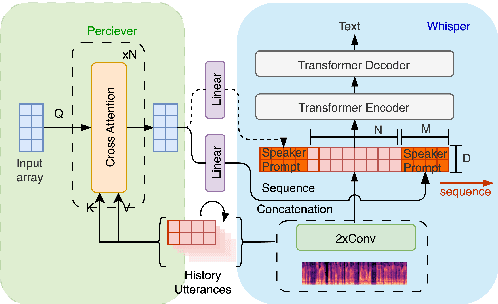
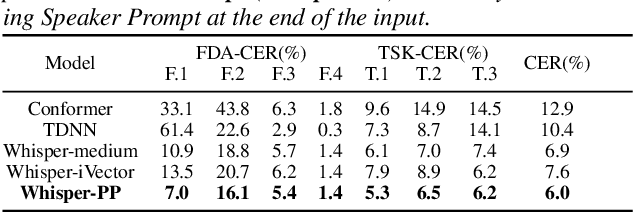
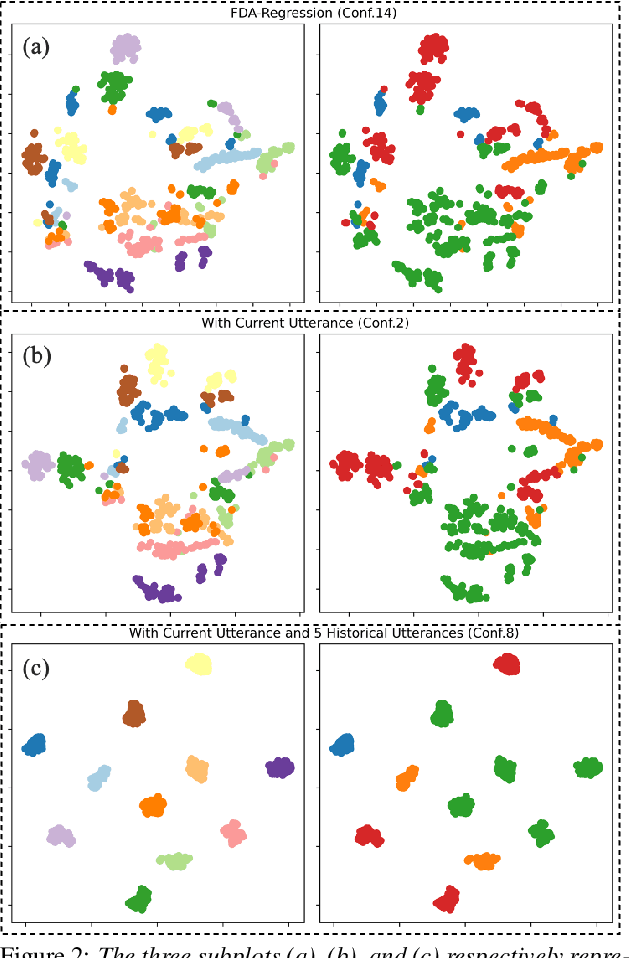
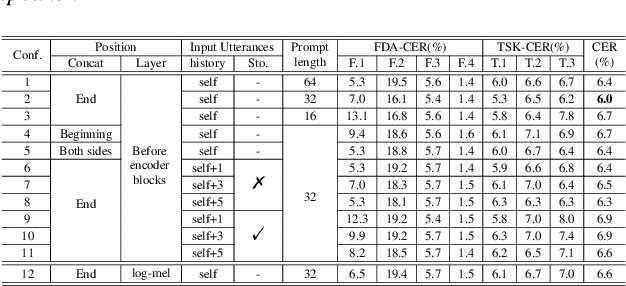
Abstract:Disordered speech recognition profound implications for improving the quality of life for individuals afflicted with, for example, dysarthria. Dysarthric speech recognition encounters challenges including limited data, substantial dissimilarities between dysarthric and non-dysarthric speakers, and significant speaker variations stemming from the disorder. This paper introduces Perceiver-Prompt, a method for speaker adaptation that utilizes P-Tuning on the Whisper large-scale model. We first fine-tune Whisper using LoRA and then integrate a trainable Perceiver to generate fixed-length speaker prompts from variable-length inputs, to improve model recognition of Chinese dysarthric speech. Experimental results from our Chinese dysarthric speech dataset demonstrate consistent improvements in recognition performance with Perceiver-Prompt. Relative reduction up to 13.04% in CER is obtained over the fine-tuned Whisper.
Automatic Assessment of Dysarthria Using Audio-visual Vowel Graph Attention Network
May 07, 2024



Abstract:Automatic assessment of dysarthria remains a highly challenging task due to high variability in acoustic signals and the limited data. Currently, research on the automatic assessment of dysarthria primarily focuses on two approaches: one that utilizes expert features combined with machine learning, and the other that employs data-driven deep learning methods to extract representations. Research has demonstrated that expert features are effective in representing pathological characteristics, while deep learning methods excel at uncovering latent features. Therefore, integrating the advantages of expert features and deep learning to construct a neural network architecture based on expert knowledge may be beneficial for interpretability and assessment performance. In this context, the present paper proposes a vowel graph attention network based on audio-visual information, which effectively integrates the strengths of expert knowledges and deep learning. Firstly, various features were combined as inputs, including knowledge based acoustical features and deep learning based pre-trained representations. Secondly, the graph network structure based on vowel space theory was designed, allowing for a deep exploration of spatial correlations among vowels. Finally, visual information was incorporated into the model to further enhance its robustness and generalizability. The method exhibited superior performance in regression experiments targeting Frenchay scores compared to existing approaches.
 Add to Chrome
Add to Chrome Add to Firefox
Add to Firefox Add to Edge
Add to Edge